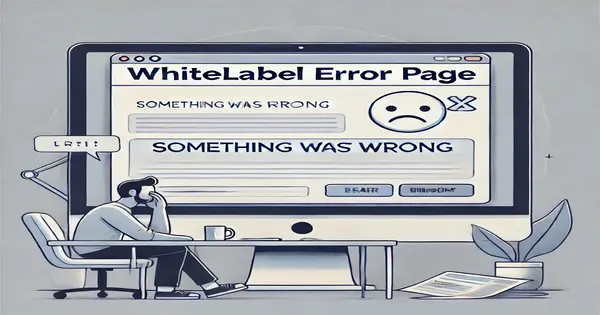Whitelabel Error Pages and Their SEO Impact
Have you ever stumbled upon a webpage that says something like “404 Error” or “Whitelabel Error Page”? If so, you’ve encountered a whitelabel error page. These pages appear when something goes wrong on a website, like a broken link or a missing file. But what exactly is a whitelabel error page, and why does it matter for SEO (Search Engine Optimization)? In this article, we’ll break it all down in simple terms, so even high schoolers can understand. By the end, you’ll know how to fix, customize, and optimize these pages to improve your website’s performance.
What is a Whitelabel Error Page?
A whitelabel error page is a default error page that shows up when a website encounters a problem. For example, if you click on a broken link, you might see a 404 error page, which is one of the most common types of whitelabel error pages. These pages are called “whitelabel” because they are usually plain and unbranded, meaning they don’t have the website’s logo or design.

Whitelabel error pages can appear for many reasons, such as a missing file, a server issue, or a misconfiguration. While they might seem like a small issue, they can have a big impact on your website’s performance and user experience. For instance, if users keep seeing error pages, they might leave your site and never return. That’s why it’s important to understand what is a whitelabel error page in SEO and how to fix it.
Common Causes of Whitelabel Error Pages
Whitelabel error pages can happen for several reasons. Let’s look at some of the most common causes:
- Misconfigurations: Sometimes, a website’s settings aren’t set up correctly. For example, if a file path is wrong, the server might not be able to find the page, resulting in a whitelabel error page after deployment.
- Server Issues: If the server hosting your website has a problem, it might display a 500 internal server error. This is another type of whitelabel error page.
- Missing Files: If a page or resource is deleted or moved without updating the links, users might see a 404 error page.
- Incorrect Permissions: If a user tries to access a page they don’t have permission to view, they might encounter a 403 forbidden error.
How They May Affect SEO
Whitelabel error pages don’t just frustrate users—they can also hurt your website’s SEO ranking. Here’s how:
- Crawlability Issues: Search engines like Google use bots to crawl websites and index their content. If these bots encounter too many error pages, they might think your site is poorly maintained, which can lower your rankings.
- User Engagement: When users see an error page, they’re likely to leave your site quickly. This increases your bounce rate, which is a metric search engines use to evaluate user experience. A high bounce rate can negatively impact your SEO.
- Broken Links: If your site has many broken links leading to error pages, it can harm your site’s credibility and authority. This is why it’s important to prevent whitelabel error for better SEO.
Fixing and Customizing Error Pages
Now that you know why whitelabel error pages are a problem, let’s talk about how to fix and customize them. Here’s a step-by-step guide:
- Identify the Error: Use tools like Google Search Console to find broken links and error pages on your site.
- Fix Broken Links: Update or remove any broken links that lead to error pages.
- Customize the Error Page: Instead of showing a plain whitelabel error page, create a custom whitelabel error page setup. Add your logo, brand colors, and a friendly message like “Oops! This page is missing. Let’s get you back on track.”
- Add Helpful Links: Include links to your homepage, popular blog posts, or a search bar to help users find what they’re looking for.
- Optimize for Mobile: Make sure your error pages look good on all devices, including smartphones and tablets.
Best Practices to Handle Error Pages
To avoid whitelabel error pages and improve your site’s SEO, follow these best practices:
- Monitor Your Site Regularly: Use tools like Google Analytics and Google Search Console to track errors and fix them quickly.
- Set Up Proper Redirects: If you move or delete a page, set up a 301 redirect to send users to a relevant page instead of an error page.
- Create SEO-Friendly Error Pages: Design error pages that are visually appealing and user-friendly. Include helpful links and a search bar to keep users engaged.
- Test Your Site: Before launching any changes, test your site thoroughly to ensure there are no broken links or misconfigurations.
Whitelabel error pages might seem like a small issue, but they can have a big impact on your website’s performance and SEO. By understanding why whitelabel error pages matter for SEO and taking steps to fix and customize them, you can improve user experience, reduce bounce rates, and boost your search engine rankings.
The Unexpected Benefits of...
Website Directory Submission Usefulness
Discover the benefits of website directory submission for SEO and online visibility. Learn how to effectively submit your website, and choose the right directories.
Rapid URL Indexer: How It Works, Best SEO Tools & Fast Guide
Discover how Rapid URL Indexer works, why it’s an essential SEO tool, and explore the best SEO tools like Rapid URL Indexer for faster Google indexing.
Whitelabel Error Pages and Their SEO Impact
Learn about whitelabel error pages and their impact on SEO. Discover how to fix, customize, and optimize these pages to improve website performance, reduce bounce rate, and boost search engine rankings.
| Random Directories | URL | Type |
|---|---|---|
| Sublime Link | http://www.sublimelink.org/ | Instant |
| Phenomenal Articles | https://phenomenalarticles.com/ | Article |
| iGlobal | https://www.iglobal.co/ | Classified |
| Directory 3 | http://www.directory3.org/ | Instant |
| Fark | https://www.fark.com/ | Social |
